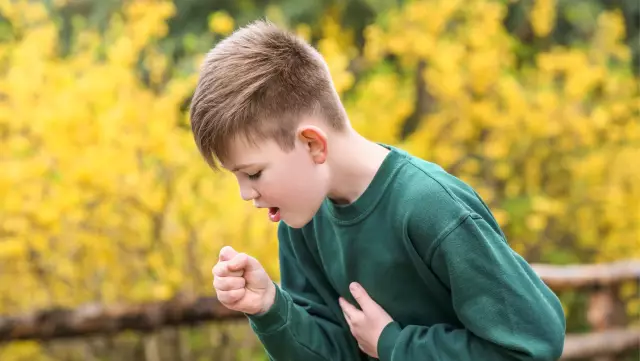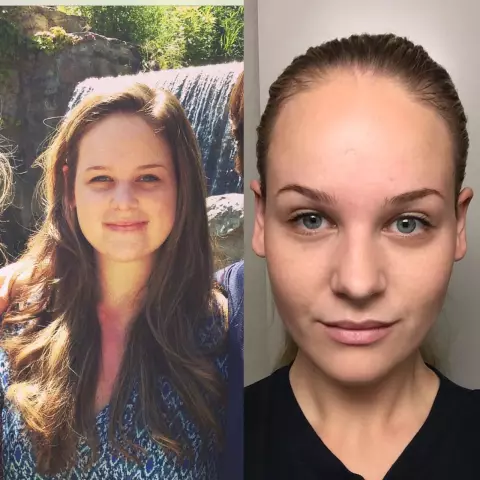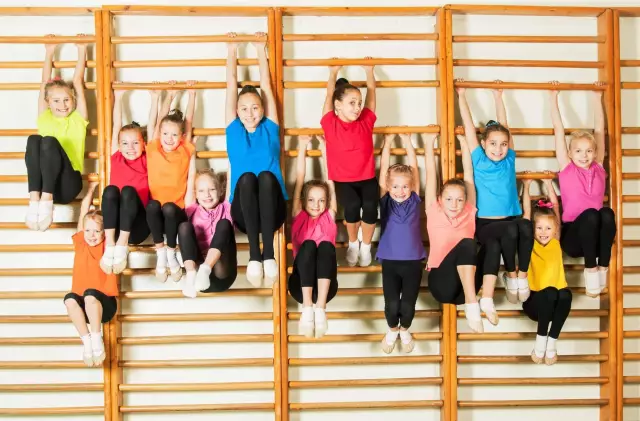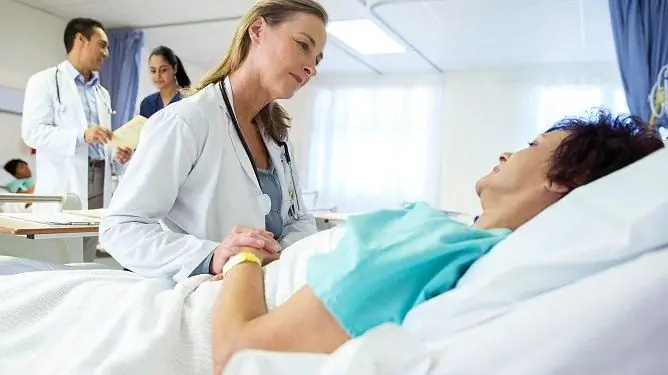- Author Rachel Wainwright [email protected].
- Public 2023-12-15 07:39.
- Last modified 2025-11-02 20:14.
Hallux valgus in children
The content of the article:
- Causes and risk factors
- Forms of the disease
- Symptoms
- Diagnostics
- Treatment of hallux valgus in children
- Possible complications and consequences
- Forecast
- Prevention
Hallux valgus in children is an orthopedic disease in which there is a deformity of the foot with the heel and toes turning outward (X-shaped curvature). In this case, the omission of the middle part of the foot is noted.

Stages of hallux valgus in children
The shape of a person's foot ensures an even distribution of his body weight. The bones of the foot are connected by interosseous ligaments and form the arch of the foot, which provides amortization of movements when walking, running, jumping. Normally, the foot of an adult has three points of support (fifth metatarsal bone, calcaneal tubercle, head of the first metatarsal bone).
Hallux valgus is a common orthopedic defect in children. In the absence of adequate correction, the disease in the future can lead to the development of complications.
Causes and risk factors
Congenital hallux valgus of the foot is formed during intrauterine development. The start of the pathological process is given by a violation of the shape and / or location of the bones of the foot. Deformity can form against the background of dysplasia or with intrauterine injury to the musculoskeletal system.
The main reasons for the development of acquired hallux valgus in children include dysfunctions of the musculoskeletal system, which may not manifest themselves during the first year of a child's life until he begins to try to stand on his own. Pathology can develop in children with weakened muscle tone against the background of acute respiratory viral infections, bronchitis, pneumonia transferred at an early age. The acquired form of hallux valgus in children occurs with rickets, myodystrophy, infantile cerebral palsy. Often the pathological process develops with ligament injuries and dislocations of the lower extremities in children of the first year of life, as well as with too early attempts by the child to walk fully, when wearing improperly selected shoes and overweight child. The presence of obesity against the background of weakened muscle tone leads to a flattening of the arch of the foot, due to which the muscles and ligaments of the leg weaken and become unable to maintain the normal position of the lower limb. The disease can also occur in sedentary children who do not exercise at home and in preschool institutions.

The cause of hallux valgus in children can be ligament injuries and dislocations of the lower extremities
Genetic predisposition, prematurity, transverse flat feet, endocrine diseases, osteoporosis can contribute to the development of foot deformity in children. Hallux valgus in children can be a consequence of injuries to the bones of the lower leg and foot, ligaments, muscles and prolonged immobilization of the lower limb in a cast. Risk factors for the development of the disease also include inappropriate nutrition and a lack of calcium and other essential macro- and microelements in the child's body.
Forms of the disease
Depending on the etiological factor, hallux valgus in children is of the following types:
- congenital;
- rickety;
- paralytic;
- traumatic;
- overcorrection in the treatment of clubfoot;
- static.

How to understand that a child has hallux valgus
Depending on the severity of the disease and the degree of deformation, 4 degrees of pathology are distinguished:
- Deviation by 10-15 degrees.
- Deviation by 15-20 degrees.
- Deviation by 20-30 degrees.
- More than 30 degrees deflection.
Symptoms
Hallux valgus in children develops gradually. The first signs of the disease are usually found when the child begins to walk. It is noteworthy that the child does not step on the entire foot, but on its inner edge. With the development of the pathological process, the child develops an X-shaped foot, the gait becomes shuffling, clumsy, uncertain. Children quickly get tired of walking and active games, complain of pain in the spine and lower limbs. Often they prefer passive activities to outdoor games, which are unusual for their age. By the evening, the child's foot may swell, sometimes there are cramps in the calf muscles. When examining the child's shoes, attention is drawn to the fact that it is trampled unevenly (more on the inner side of the sole).

With hallux valgus, the child does not step on the entire foot, but on its inner edge
Diagnostics
The primary diagnosis of hallux valgus in children is carried out on the basis of data obtained during an objective examination of the patient, collection of complaints and anamnesis, and is confirmed by the results of instrumental examination.
If there is a suspicion of hallux valgus in children:
- X-ray examination of the feet in three projections;
- computer plantography (obtaining foot prints to determine flat feet);
- podometry (computer diagnostics of the foot, which allows to determine how the load from the pressure of the body weight is divided into different parts of the foot);
- ultrasound examination of the joints of the lower extremities.

To diagnose valgus diagnostics of the foot in children, computer plantography is performed - obtaining foot prints
Differential diagnosis is required with juvenile arthritis, gout, deforming osteoarthritis. To exclude diseases of the central and peripheral nervous system, you may need to consult a pediatric neurologist, and if you suspect a metabolic disease, an endocrinologist.
Treatment of hallux valgus in children
In the early stages of the disease, the correction of hallux valgus in children is possible by wearing individually made orthopedic insoles with parallel sessions of massage and physiotherapy exercises.
Massage is used to normalize the position of the anatomical structures of the deformed foot, as well as to strengthen the musculo-ligamentous apparatus. In addition, massage for hallux valgus in children helps to improve blood supply to the feet, normalize muscle tone, and increase the elasticity of the ligaments. Sessions can be conducted both in the massage room and at home by a specialist or parents after training, the duration of each is 15-20 minutes, the frequency is every other day. The course of therapeutic massage takes from two weeks to a month, depending on the severity of the disease and the response to therapy.

Massage for hallux valgus in children helps to strengthen the musculo-ligamentous apparatus
In addition, swimming and physiotherapy exercises are shown. Gymnastic exercises for hallux valgus in children alternate with massage and are selected individually for each patient. Usually, the set of exercises includes flexion of the soles, alternate flexion of the toes of the lower extremity, rotations of the feet with the soles inward, rotation of the feet, gripping with the feet and lifting small objects from the floor, etc.
The main treatment is complemented by physiotherapeutic procedures: foot baths, mud, paraffin and ozokerite applications, magnetotherapy, electrical stimulation of the muscles of the foot and lower leg, diadynamic therapy, acupuncture.
In difficult cases, children with hallux valgus require immobilization of the lower extremities, which is carried out with the help of plaster casts.
Dobbs method - staged plastering of a limb with further percutaneous fixation using a Kirschner wire; used in the treatment of certain types of hallux valgus in children. It is based on the fact that in children the tissues of the foot have plasticity, and this allows gradually, using gentle massage techniques, to achieve the normalization of the anatomical position of the joints of the foot. In total, 5-6 sessions (one per week) of manual correction are carried out, each session ends with plastering in order to securely fix the feet in the position of the maximum possible correction. A plaster cast is applied from the upper third of the thigh to the toes with the knee bent at a 90 ° angle. The last stage of Dobbs' treatment consists in operative fixation of the talo-navicular joint in the correct position (percutaneously using the Kirschner wire and under the control of an image converter) and complete achillotomy (also percutaneous access). After the performed manipulations, a plaster cast is applied to the limb for up to two months. To prevent relapses, patients are shown wearing braces for up to 4 years and orthopedic shoes in the future.

With hallux valgus in children, wearing special orthopedic shoes is indicated
In severe forms of deformity, surgical treatment is indicated, the need for it arises in about 7% of cases. Osteotomy in this case is a bone reconstruction, in which there is an intervention on several bones of the foot in order to change the axis of the metatarsal bone, as well as the first phalanx of the big toe of the affected lower limb. In this case, the patient can walk, fully relying on the metatarsus, from about the third week after the operation. The rehabilitation period lasts 2-3 months.
Patients are selected or manufactured individually functional insoles or orthopedic shoes with rigid lateral fixation of the heel and foot, an instep support.
Possible complications and consequences
In the absence of treatment, hallux valgus in children can cause the development of the following complications: chronic bursitis, marching foot (Deichlander's disease), hallux valgus of the ankle and knee joints, shortening of the limb, poor posture, incorrect position of the pelvis, osteochondrosis, arthrosis.
Forecast
With a slight degree of deformity and timely adequate treatment, the prognosis is favorable. Severe forms of the disease in the absence of specialized care lead to functional disorders of the affected limb, which is expressed in pain when walking, fatigue, and the inability to engage in certain sports.
Prevention
In order to prevent the development of hallux valgus in children, it is recommended:
- elimination of the load on the legs until the child reaches 7-8 months of age;
- rickets prevention;
- regular preventive examinations of the child by a pediatrician (if necessary, consultations of narrow specialists, for example, a surgeon, orthopedist, endocrinologist);
- rational nutrition, balanced in the composition of macro- and micronutrients;
- preventive foot massage;
- selection of comfortable high-quality shoes for the child;
- sufficient physical activity.
YouTube video related to the article:

Anna Aksenova Medical journalist About the author
Education: 2004-2007 "First Kiev Medical College" specialty "Laboratory Diagnostics".
The information is generalized and provided for informational purposes only. At the first sign of illness, see your doctor. Self-medication is hazardous to health!






